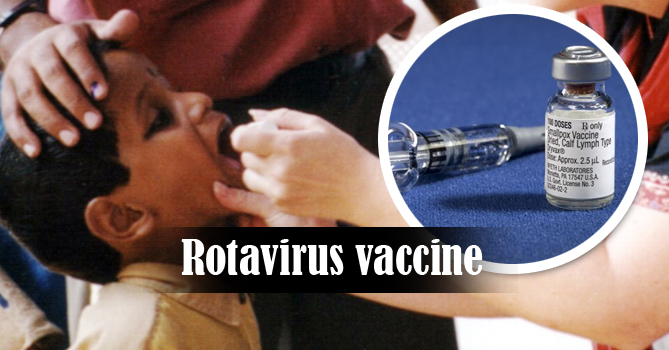On March 26 2016, the ministry of health launched the rotavirus vaccine in India as a part of its universal immunisation programme. The objective is to prevent diarrhoeal deaths caused due to the rotavirus. Rotavirus vaccine is used to protect young children against rotavirus infections. Before getting to know more about rotavirus vaccine, let us know in details about the rotavirus infection.
What is rotavirus?
Rotavirus is a type of virus that is the main cause of severe diarrhoea among young children and infants throughout the world. The virus causes an inflammation of the stomach and bowels, medically termed as severe gastroenteritis. It infects the intestinal tract of almost all young children by age 5.
Rotavirus infection facts
- The virus causes the death of about 500,000 children worldwide annually.
- In India, between 80,000 to one lakh children die due to rotavirus diarrhoea every year, while almost 9 lakh children are admitted to hospital with severe diarrhoea.
- Every year, approximately 1,27,000 children aged less than five years die of the disease in the South East Asian Region.
- The virus has a wheel-like appearance when observed by electron microscopy. Hence, its name is derived from the Latin word “rota” meaning “wheel”.
- Rotavirus is a member of the Reoviridae family of viruses.
- There are different strains of the virus and hence children can be affected by several separate rotavirus infections.
- Adults can also be affected with this virus but the severity is more among children than in adults.
- Rotavirus infection is highly contagious. The incubation period is around two days.
Symptoms of Rotavirus infection
- Fever
- Vomiting
- Watery diarrhoea
Rotavirus vaccine
The rotavirus vaccine was first introduced in the United States in 2006. Today, this vaccine is on the list of the World Health Organization’s “List of Essential Medicines”. The vaccine is considered to be the most important requirement in a basic health system.
When should this vaccine be taken?
- According to the WHO, this vaccine should be included in routine vaccinations.
- The vaccination is all the more necessary in areas where the disease is common.
- It is given by mouth and requires two or three doses.
- It should be given before a child turn 2 months.
- It is not recommended to babies who have had intussusception (a medical condition in which a part of the intestine folds into another section of intestine).
- The WHO also recommends promoting hand washing, breastfeeding, clean water and good sanitation, along with the vaccination.
Types of rotavirus vaccine
There are two types of vaccine available globally as of 2013. These are Rotarix and RotaTeq.
- RotaTeq® (RV5) is given in 3 doses at ages 2 months, 4 months, and 6 months.
- Rotarix® (RV1) is given in 2 doses at ages 2 months and 4 months
It is recommended a child should be given the first dose when he or she is 15 weeks old. The first dose is most effective at this age. Also, children should receive all doses of rotavirus vaccine before they turn 8 months old.
Rotavirus vaccine facts
- According to the WHO, the rotavirus vaccine has prevented almost 15 to 34% of severe diarrhoea in the developing world. In the developed world, it has prevented 37 to 96% of severe diarrhoea.
- The rotavirus vaccine has decreased the risk of death among young children on account of diarrhoea.
- Immunized babies have seen decrease rates of disease as compared to older people and those who have not been vaccinated.
- Safety and efficacy trials in Asia and Africa found that the vaccines reduced severe disease among infants in developing countries.
- In 2012, Cochrane review concluded that these are effective vaccines.
Rotavirus vaccine in India
Health minister J P Nadda said that the launch of the vaccine is an exemplary step towards effective India’s immunisation programme and it is an essential investment in children. He also said that the development of rotavirus vaccine indigenously under a public-private partnership is a remarkable achievement under the “Make in India” initiative. The vaccine, developed by Indian firm Bharat Biotech in collaboration with the ministries of science and technology and health and family welfare, was introduced in four states initially – Andhra Pradesh, Haryana, Himachal Pradesh and Odisha. In a phased manner, its coverage will be expanded to the entire country. It would also be launched in Uttar Pradesh before the end of this year. The vaccine can save at least 12,000 children from untimely death caused by diarrhoea in Uttar Pradesh.
With the introduction of the vaccine in India, the WHO remarked that this marks an “immensely important” step for the health and well-being of the country’s children.
Explore More :
What is Anthrax ? : Symptoms, Treatment, Prevention Measures
Is India Prepared for Zika Virus: Guidelines, Symptoms, Diagnosis & Treatment
Is India Close To Developing The Zika Virus Vaccine?
Genital Tuberculosis: Causes, Symptoms and Remedy
Leprosy – Causes, preventions and eradication programme
Japanese Encephalitis in India – Guidelines for Prevention, Control & Symptoms
Hepatitis B in India: Guidelines for Prevention, Symptoms, Causes, Risks & Treatment
Ebola Virus Outbreak – Is India Prepared?
Prevalence of Diabetes in India
Prevention of Heart Attack and Other Related Heart Diseases
India To Be Certified As A Polio-free Nation By WHO
Swine Flu: What You Need to Know and Do
Cervical Cancer: Causes, Symptoms, Prevention and HPV Vaccination
Growing Problem of Asthma in India





